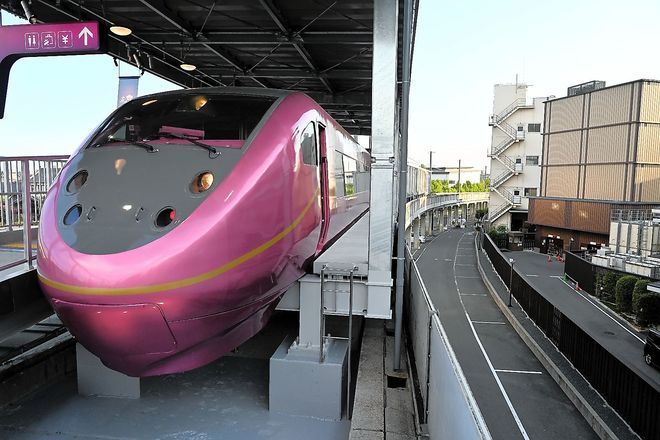KYOTO—A sign on a train platform directs visitors to “The Future,” a pink-colored venue filled with cuteness that has made history on an abandoned railway line here.
The Future Train restaurant, built on top of elevated tracks in Kyoto’s Shimogyo Ward, consists of three cars of the decommissioned Thunderbird limited express service that connected the Kansai and Hokuriku regions.
According to West Japan Railway Co. (JR West), the elevated section was part of the Umekoji Tanrakusen Line, which gave freight trains and other services a 2.3-kilometer shortcut between the Tokaido Line and the Sagano Line.
The Umekoji Tanrakusen Line was shut down in 2016 for construction work to build Umekoji-Kyotonishi Station, which opened in 2019 on the Sagano Line between Kyoto and Tanbaguchi stations.
Customers enter Future Train through a “ticket gate” on the disused elevated tracks that are directly connected via a walkway to Umekoji-Kyotonishi Station, where the abolished Umekoji Tanrakusen Line and the Sagano Line run side by side.
The platform and restaurant offer views of the five-story pagoda at Toji temple, a World Heritage site, bullet trains running on the Tokaido Shinkansen Line, and Kyoto Tower.
Car No. 1 of Future Train is a remodeled first car of a 681-series Thunderbird train. It has been repainted in light pink to express a sense of “kawaii” (cuteness).
The interior is essentially an art space where customers can enjoy installations using video and other media sources. Staff in costume add to the futuristic experience.
Car No. 2 is the dining car, which mainly serves Western-style lunches and dinners.
Car No. 3 features a bar counter and box seats, with a kitchen carriage and a terrace farther back.
The first car was brought from a rail yard in Suita, Osaka Prefecture, in April and lifted by crane onto the tracks.
“Everything, from the design to structural analysis to construction itself, was new for everyone involved. No one had any experience,” said Ken Tsuchiya, a senior official of Tokyo-based DD Group Co., the parent company of Diamond Dining Co., which operates the restaurant. “We want to cultivate it into a place cherished as a new place of interest in Kyoto.”
Spaces under elevated railway tracks have been used for “izakaya” pubs, vegetable production and other purposes in recent years across Japan.
But the Future Train project is the first in Japan to use space above elevated rail tracks.
Numerous issues had to be overcome, including installing water supply and sewerage systems, providing gas and electricity and meeting earthquake-resistance standards.
Eleven organizations and companies, including the Kyoto city government, JR West, Kyoto Station Building Development Co. and local financial institutions, joined forces for the project.
Each partner recognized that the undeveloped site was contributing nothing to the creation of a bustling atmosphere like that seen around JR Kyoto Station.
Sebastian Masuda, who has been promoting Japan’s kawaii culture to the world, designed the restaurant. He is also a railway fan, being mesmerized by the “Galaxy Express 999” anime series.
The “to The Future” sign appears on “Platform No. 1.”
It is well known among rail buffs like Masuda that Kyoto Station has a Platform No. 0. But there is no Platform No. 1 due to past repair work on the station building.
Masuda said he wanted to appeal to train enthusiasts by making them believe that the phantom Platform No. 1 at the restaurant has transcended time and space and will take customers to an unknown future.
Admission is 700 yen ($4.70) for junior high school students or older, 300 yen for elementary school pupils and free for preschoolers. Future Train requires diners to order at least one dish per person.


AloJapan.com